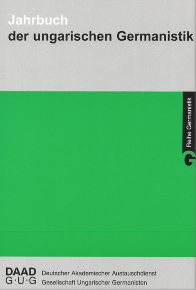Jahrbuch der ungarischen Germanistik 2024, S. 86–101.
Was die maschinelle Übersetzung (MÜ) nicht kann: Übersetzung des grammatischen Genus am Beispiel des Sprachenpaares Deutsch <> Ungarisch
Eötvös-Loránd-Universität Budapest
Diese E-Mail-Adresse ist vor Spambots geschützt! Zur Anzeige muss JavaScript eingeschaltet sein!
Diese E-Mail-Adresse ist vor Spambots geschützt! Zur Anzeige muss JavaScript eingeschaltet sein!
DOI: https://doi.org/10.69962/JUG.2025.6
Abstract:
This article examines the challenges faced by machine translation (MT) systems in handling grammatical gender when translating between German and Hungarian, with a focus on the linguistic representation of natural gender (sexus). While German employs a tripartite gender system, Hungarian lacks grammatical gender entirely. This asymmetry leads to significant translation issues, particularly in rendering personal or occupational references where the target language (German) requires gender-specific forms. Through empirical analysis of translations generated by DeepL and Google Translate, the study demonstrates that both systems tend to default to masculine forms when explicit gender markers are absent and struggle to interpret contextual clues accurately. Key problem areas include pronominal reference and coreference, proper names with lexical ambiguity, translation of gender-neutral occupational terms, and what the authors term „gender-based valency“ – the culturally conditioned association of certain activities with a specific gender. The findings reveal inconsistent strategies and stereotypical mappings, which may result in semantic inaccuracies or misinterpretation. Translations between German and Hungarian in neural networks are not made directly but via English as an intermediate step. This circumstance, too, makes post-editing indispensable. The paper concludes that in sensitive contexts, MT systems cannot ensure adequate semantic and stylistic precision without human post-editing. It argues for a critical engagement with MT in professional translation and underscores the importance of integrating post-editing skills into translation training curricula.
Keywords:
Machine Translation; Grammatical Gender; German–Hungarian; Gender-inclusive Language; Pronominal Reference and Coreference, Proper Names with Lexical Ambiguity, Translation of Gender-neutral Occupational Terms, Artificial Intelligence; Post-editing; Context Sensitivity; Occupational Terms
References:
Bar-Hillel, Yehoshua (1967): Die Zukunft der maschinellen Übersetzung oder warum Maschinen das Übersetzen nicht erlernen. In: Sprache im technischen Zeitalter 21, S. 210–238.
Catford, John C. (1965): A Linguistic Theory of Translation. An Essay in Applied Linguistics. London: Oxford University Press.
Ertel, Wolfgang (2016): Grundkurs Künstliche Intelligenz. Eine praxisorientierte Einführung. 4., überarbeitete Aufl. Wiesbaden: Springer Vieweg.
Fiedler-Tresp, Sonja (2025): Wie umgehen mit Aufträgen zum Post-Editing? https://lektorenverband.de/interview-mit-vdue-mitglied-andre-hansen-und-janine-malz-zum-post-editing/ (letzter Zugriff: 13.03.2025).
Forssmann, Berthold (2023): Sprachen ohne Genus – wie geht das? https://forssman-uebersetzer.de/baltikum/sprachen-ohne-genus/ (letzter Zugriff: 04.05.2025).
Hauenschild, Christa (2004): Maschinelle Übersetzung – die gegenwärtige Situation“. In: Kittel, H. et al. (Hg.): Übersetzung. Translation. Traduction. 1. Teilband: Ein internationales Handbuch zur Übersetzungsforschung. Berlin/New York: de Gruyter Mouton, S. 756–766. https://doi.org/10.1515/9783110137088.1.9.756
Heinisch, Barbara (2020): Werden Übersetzer*innen in Zukunft durch maschinelle Übersetzung ersetzt? Universität Wien. https://blog.univie.ac.at/forschung/maschinelle-uebersetzung/ (letzter Zugriff: 03.12.2024).
Koller, Werner (2001): Einführung in die Übersetzungswissenschaft. 6., durchgesehene und aktualisierte Aufl. Wiebelsheim: UTB.
Łopuszańska, Grażyna (2019): Maschinelle Übersetzung – Grenzen und Möglichkeiten. In: Linguistische Treffen in Wrocław 15 (1), S. 145–156.
[Mainpost] (2009): Europa-Union Hammelburg bereiste Nordindien. https://www.mainpost.de/regional/bad-kissingen/europa-union-hammelburg-bereiste-nordindien-art-5056583/ (letzter Zugriff: 22.04.2025).
Massion, François (2020): Maschinelle Übersetzung. https://www.dog-gmbh.de/wp-content/uploads/2022/05/Whitepaper-Maschinelle-Ubersetzung-D.O.G.-GmbH.pdf (letzter Zugriff: 22.04.2025).
Moorkens, Joss (2022): The translator, an endangered species? In: The Unesco Courier. https://courier.unesco.org/en/articles/translator-endangered-species (letzter Zugriff: 05.02.2025). https://doi.org/10.18356/22202293-2022-2-10.
Nord, Chirstiane (2012): Functionalism in translation studies. In: Millán, C./Bartrina, F. (Hg.): The Routledge Handbook of Translation Studies. London/New York: Routledge, S. 201–212. https://doi.org/10.4324/9780203102893-24.
Neidhardt, Miriam (2022): Kann man ein Buch mit DeepL übersetzen? https://www.miriam-neidhardt.de/2022/07/29/uebersetzung-eines-romans-mit-deepl-ein-selbstversuch/?fbclid= IwAR2TET6XvfoZb_i3CNNLoTD2M2lHuk0q1XFTbEk1hMuwXIm41i-DfMqCg8_aem _ASCXlnHpBuADVGty1MW8UGj0J6WYydm8cd11r6oR0csMULh2tQEJx5ij0oKOp9AqlP2lxTjIxNc46Y-9Qi1M3CKn (letzter Zugriff: 05.02.2025).
Oettinger, Anthony G. (1960): Automatic Language Translation: Lexical and Technical Aspects, with Particular Reference to Russian. Cambridge/Massachusetts. https://doi.org/10.4159/harvard.9780674421974.
Prószéky, Gábor (2023): Terminológia és neurális hálók. In: Prószéky, G. et al. (Hg.): A magyar terminológiastratégia kialakítása. Zöld könyv. Budapest: Nyelvtudományi Kutatóközpont, S. 185–197.
Rivera-Trigueros, Irene (2022): Machine translation systems and quality assessment: a systematic review. In: Lang Resources & Evaluation 56, S. 593–619. https://doi.org/10.1007/s10579-021-09537-5.
Rothkegel, Annelie (2004): Geschichte der maschinellen und maschinenunterstützten Übersetzung. In: Kittel, H. et al. (Hg.): Übersetzung. Translation. Traduction. 1. Teilband: Ein internationales Handbuch zur Übersetzungsforschung. Berlin/New York: de Gruyter Mouton, S. 748–756. https://doi.org/10.1515/9783110137088.1.9.748.
